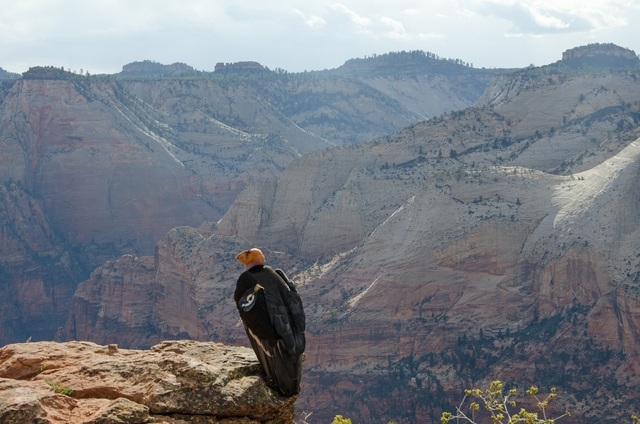Pair of California condors nesting at Zion National Park gives officials hope
Officials at Zion National Park in Utah are anxiously watching a nesting pair of California condors that could deliver the park its first fledgling.
Staff members first spotted the pair entering a cave in Zion Canyon on Feb. 26. Since then, the critically endangered birds have been seen regularly in the cave and the surrounding area.
Biologists from The Peregrine Fund, a private nonprofit group that releases and monitors condors, confirmed that the pair appears to be incubating an egg based on GPS data and observed behavior.
According to the National Park Service, it is not unusual for condors to fail at reproduction in their first few attempts, and this pair has tried to nest in each of the past two years in remote areas of the park.
The pair produced a chick in 2014, but it died. Then last year, GPS data suggested the pair might be nesting again, but observers “never got eyes” on the nest or spotted a young bird in the area, said Cassie Waters, a wildlife biologist at the park 160 miles northeast of Las Vegas.
“We are very, very hopeful this time, and so far it seems like everything is going well,” she said.
The California condor is the largest land bird in North America. It used to range across the continent until the 20th century, when poaching, lead poisoning and habitat loss caused its numbers to plummet. The bird was declared extinct in the wild in 1987, but captive-bred condors have since been reintroduced to the coastal mountains of California and northern Mexico.
The condors at Zion came from an experimental recovery program launched in 1996 at Vermilion Cliffs National Monument on Arizona’s northern border.
That effort has produced more than 20 young so far, including some birds fledged from nests established by wild-hatched condors. Waters said there are now about 80 California condors living in Utah and Arizona.
Lead poisoning remains the biggest threat to the species of scavengers, which unintentionally ingest the toxic metal while feeding on the carcasses or gut piles of animals shot with lead ammunition.
Condors usually pair up and choose a nest site during the winter months and produce a single egg between late January and early April. Both parents will incubate the egg until it hatches after about two months, then feed and care for the young condor for another five to seven months. Even after the chick leaves the nest, it will depend on its parents for up to a year.
The area in Zion Canyon where the pair appears to be nesting has been closed to rock climbing.
Waters said park rangers and volunteers are setting up a nest-watch program at the Zion Human History Museum, where spotting scopes will be used to monitor the cave from a distance. Visitors who are interested in joining the nest watchers should inquire at the park’s visitor center or the museum, she said.
Contact Henry Brean at hbrean@reviewjournal.com or 702-383-0350. Follow @RefriedBrean on Twitter.
RELATED
California condor chick hatched in Zion has died, scientists say

















